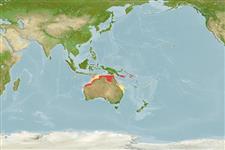Elasmobranquios (tiburones y rayas) (sharks and rays) >
Carcharhiniformes (Ground sharks) >
Carcharhinidae (Requiem sharks)
Etymology: Carcharhinus: karcharos (Gr.), sharp or jagged; rhinus, an ancient name for sharks, from rhine (Gr.), rasp, both words alluding to a shark's jagged, rasp-like skin (See ETYFish); tilstoni: In honor of Richard Tilston, naturalist-surgeon at Port Essignton, Northern Territory, near where holotype was collected in the 1840s (See ETYFish).
Eponymy: Richard Tilston was a naturalist who trained as a physician at Guy’s Hospital, London (1841) and became a naval surgeon (1842). [...] (Ref. 128868), visit book page.
More on author: Whitley.
Environment: milieu / climate zone / depth range / distribution range
Ecología
marino; salobre; rango de profundidad 0 - 150 m (Ref. 6871). Tropical; 10°S - 28°S
Distribución
Países | Áreas FAO | Ecosistemas | Ocurrencias, apariciones | Point map | Introducciones | Faunafri
Indo-West Pacific: currently known only from the continental shelf of tropical Australia. Very similar to Carcharhinus limbatus and reliably distinguished only by biochemical studies and vertebral counts (Ref. 9819).
Length at first maturity / Tamaño / Peso / Age
Maturity: Lm ?, range 115 - ? cm
Max length : 200 cm TL macho / no sexado; (Ref. 9997); peso máximo publicado: 52.0 kg (Ref. 6390); edad máxima reportada: 12 años (Ref. 6390)
Espinas dorsales (total) : 0; Espinas anales: 0. Back dark grey, ashy blue or dusky bronze; belly white or yellowish white; a dark band extending rearward along each side to about over origin of pelvic fin; tips of pelvic fins with a persistent black spot (Ref. 9997).
Found on the continental shelf from close inshore to about 150 m depth (Ref. 9997). Found throughout the water column but usually near the sea bed during the day and near the surface at night (Ref. 6390). Prefers teleost fishes but also feeds on cephalopods to a lesser degree. Viviparous (Ref. 50449). Forms large aggregations (Ref. 6871). Utilized for its meat and fins (Ref. 6871). The flesh has a relatively high mercury content (Ref. 6871).
Viviparous, placental (Ref. 50449). The average litter size is 3, with a range of 1-6, average total length at birth is 60 cm. Pups are born in January after a 10-month gestation period. These sharks breed once each year (Ref. 13440). Distinct pairing with embrace (Ref. 205).
Kailola, P.J., M.J. Williams, P.C. Stewart, R.E. Reichelt, A. McNee and C. Grieve, 1993. Australian fisheries resources. Bureau of Resource Sciences, Canberra, Australia. 422 p. (Ref. 6390)
IUCN Red List Status (Ref. 130435: Version 2024-1)
Threat to humans
Harmless
Human uses
Pesquerías: escaso valor comercial
Herramientas
Special reports
Download XML
Fuentes de Internet
Estimates based on models
Preferred temperature (Ref.
123201): 26 - 28.7, mean 27.7 °C (based on 424 cells).
Phylogenetic diversity index (Ref.
82804): PD
50 = 0.5000 [Uniqueness, from 0.5 = low to 2.0 = high].
Bayesian length-weight: a=0.00513 (0.00236 - 0.01115), b=3.08 (2.91 - 3.25), in cm total length, based on LWR estimates for this Genus-body shape (Ref.
93245).
Nivel trófico (Ref.
69278): 4.2 ±0.6 se; based on diet studies.
Generation time: 7.8 ( na - na) years. Estimated as median ln(3)/K based on 2
growth studies.
Resiliencia (Ref.
120179): Bajo, población duplicada en un tiempo mínimo de 4.5-14 años (K=0.14; tm=3-4; tmax=12).
Fishing Vulnerability (Ref.
59153): High to very high vulnerability (70 of 100).
